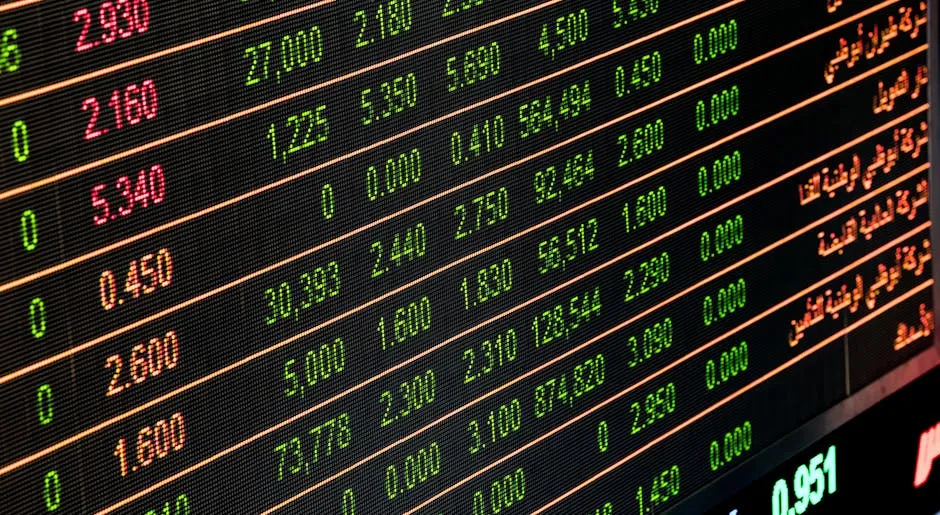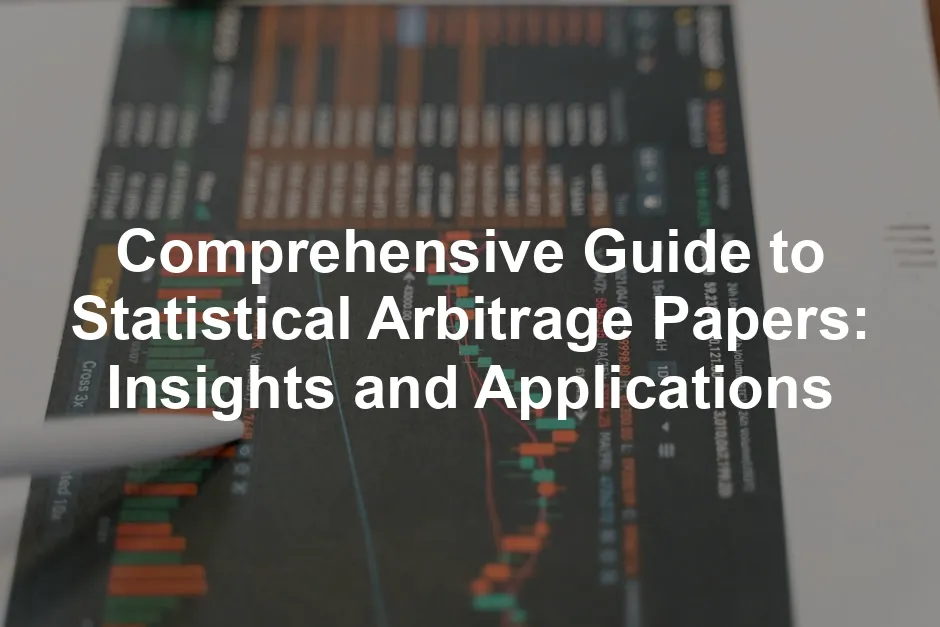Introduction
Statistical arbitrage is a fancy term for a trading strategy that capitalizes on price discrepancies. Think of it as a math-savvy trader’s best friend in the wild world of finance. It’s all about identifying mispriced assets and leveraging them for profit. This strategy holds significant weight in the realm of finance, especially with the rise of algorithmic trading. Algorithms can sniff out price inefficiencies faster than a bloodhound on a scent trail.
Why does this matter, you ask? The importance of statistical arbitrage has skyrocketed as traders embrace technology. Institutions now employ sophisticated models, making it more crucial than ever to understand the underlying principles. This article aims to shed light on the academic papers that have shaped statistical arbitrage strategies, providing you with insights into their methodologies and applications.
So, what can you expect from this article? We’ll start by breaking down the concept of statistical arbitrage, highlighting its mechanisms and historical context. After that, we’ll dive into key concepts like pairs trading and mean reversion. Finally, we’ll review influential papers that have defined the landscape of statistical arbitrage. Whether you’re a seasoned trader or a curious newcomer, this comprehensive guide is designed to enhance your understanding and application of statistical arbitrage strategies.

Understanding Statistical Arbitrage
What is Statistical Arbitrage?
Statistical arbitrage refers to a trading strategy that relies on statistical methods to identify mispriced securities. Unlike traditional arbitrage, which seeks to exploit price differentials between different markets, statistical arbitrage operates within the same market. Traders analyze historical price patterns and correlations to predict future price movements. This approach allows them to create a portfolio of long and short positions, aiming to profit from the convergence of prices over time.
The mechanism behind statistical arbitrage is rooted in the assumption that asset prices will eventually revert to their historical mean or equilibrium. By exploiting temporary deviations from this mean, traders can capitalize on short-term price movements. This strategy relies heavily on mathematical models and algorithms, making it a popular choice among quantitative traders.

Historical Context
The evolution of statistical arbitrage as a trading strategy dates back several decades. Initially, it was primarily used by hedge funds and institutional investors. However, recent advancements in technology and data analysis have democratized access to these strategies. Now, even retail traders can participate in statistical arbitrage.
Key milestones in this journey include the publication of pivotal academic papers that laid the groundwork for modern approaches. One such paper is “Statistical Arbitrage in the US Equities Market” by Avellaneda and Lee (2010). This work introduced frameworks for pairs trading and provided empirical evidence supporting the effectiveness of statistical arbitrage strategies. For more insights on effective data analysis in economics, check out the tips for effective data analysis in economics and statistics.
Understanding the historical context of statistical arbitrage strategies can enhance your trading knowledge. statistical arbitrage kaggle dataset
Over the years, more research has emerged, focusing on refining these strategies through the integration of machine learning and advanced statistical techniques. The landscape continues to evolve, with new methodologies and tools being developed. Understanding this historical context is essential for grasping the current state and future potential of statistical arbitrage in the financial markets.

Key Concepts in Statistical Arbitrage
Pairs Trading
Pairs trading is a popular strategy within statistical arbitrage. It involves selecting two correlated assets and betting on their price convergence. Imagine two friends who always wear matching outfits. If one suddenly shows up in a different color, you can bet they’ll switch back to their usual style soon enough. Similarly, pairs trading capitalizes on the tendency of asset prices to revert to their historical relationship.
This strategy has gained traction due to its market-neutral nature. Traders go long on one asset and short on another, effectively hedging against market-wide risk. The goal? Profit from the price difference while minimizing exposure to overall market movements.
Key literature has extensively analyzed pairs trading strategies. One notable paper by Krauss (2015) surveys various approaches to pairs trading. It categorizes strategies into distance, cointegration, and time-series methods. Krauss emphasizes the importance of identifying the right pairs and the optimal timing for trades. His research provides a robust foundation for understanding the effectiveness of pairs trading in statistical arbitrage.

Mean Reversion
Mean reversion is a cornerstone concept in statistical arbitrage. It suggests that asset prices will eventually return to their historical averages. Picture a rubber band: stretch it too far in one direction, and it snaps back to its original shape. This principle applies to financial markets, where prices often deviate from their intrinsic values, only to revert over time.
The application of mean reversion in statistical arbitrage is crucial. Traders use statistical models to identify when an asset’s price is significantly above or below its mean. They then initiate trades based on the expectation that the price will revert. Numerous studies support this notion, demonstrating that price movements often exhibit mean-reverting behavior.
Recent research has introduced reinforcement learning frameworks to enhance mean-reversion strategies. These frameworks adaptively learn from market conditions, refining trading decisions based on historical patterns. By integrating machine learning, traders can identify optimal entry and exit points, increasing their chances of success in mean-reversion trades.

Machine Learning in Statistical Arbitrage
Machine learning is revolutionizing the landscape of statistical arbitrage. Traders increasingly incorporate AI techniques to improve their strategies. The integration of machine learning allows for more sophisticated analysis of vast datasets, leading to better-informed trading decisions.
A significant contribution to this field is the paper “Deep Learning Statistical Arbitrage” by Guijarro-Ordonez et al. (2021). This research presents a comprehensive framework that employs deep learning techniques to construct arbitrage portfolios. The authors utilize convolutional transformers to extract actionable signals from time series data. Their findings reveal that machine learning-based strategies consistently outperform traditional approaches, achieving higher mean returns and Sharpe ratios. To dive deeper into the world of algorithmic trading and improve your skills, check out Algorithmic Trading: Winning Strategies and Their Rationale by Ernie Chan. It’s a must-read for anyone serious about trading!
As machine learning continues to evolve, its applications in statistical arbitrage grow more complex and effective. Advanced algorithms can analyze patterns in price movements, allowing traders to develop dynamic strategies that adapt to changing market conditions. This fusion of finance and technology is shaping the future of statistical arbitrage, making it more accessible and potentially profitable for traders at all levels.

Review of Influential Statistical Arbitrage Papers
Classic Papers
Overview of Foundational Works
Statistical arbitrage has roots in robust academic research, with several seminal papers paving the way for modern strategies. One standout is the work by Avellaneda & Lee (2010), titled “Statistical Arbitrage in the US Equities Market.” This paper is a cornerstone in understanding statistical arbitrage, providing a comprehensive framework for pairs trading. The authors present empirical evidence supporting the effectiveness of these strategies, creating a template for future research and applications. If you’re looking to get started with Python programming for finance, don’t miss Python Programming for Finance by Yves Hilpisch.
Avellaneda and Lee’s study emphasizes the significance of mean reversion and cointegration in pairs trading. They meticulously analyze asset correlations and propose methodologies for constructing optimal trading portfolios. Their work has inspired countless researchers and practitioners, influencing the way traders approach statistical arbitrage today.

Impact on Strategy Development
The impact of classic papers extends beyond theoretical frameworks; they fundamentally shape trading strategies. For instance, Avellaneda & Lee’s insights on pairs trading encouraged traders to adopt systematic approaches. Their empirical findings provided a validation of strategies that exploit price discrepancies between correlated assets.
As a result, many institutions shifted towards algorithmic trading. Algorithms can process vast amounts of data, allowing for quicker identification of arbitrage opportunities. Thus, the foundational works not only laid the groundwork for statistical arbitrage but also spurred the development of sophisticated trading systems.

Recent Advances
Contemporary Research
Recent years have seen a surge in innovative approaches within the realm of statistical arbitrage. A notable paper is “Deep Learning Statistical Arbitrage” by Guijarro-Ordonez et al. (2021). This research introduces a data-driven framework that harnesses the power of machine learning. The authors construct arbitrage portfolios using advanced signal extraction techniques, particularly convolutional transformers. To keep up with the latest trends, consider reading Machine Learning for Asset Managers by Marcos López de Prado.
Their comprehensive empirical analysis reveals that machine learning can significantly enhance traditional statistical arbitrage strategies. By optimizing trading policies based on robust signals, they achieve consistently high returns and Sharpe ratios. The integration of machine learning not only improves the performance of existing strategies but also opens avenues for developing new ones.

Case Studies
The implementation of these modern techniques has yielded remarkable results. For instance, Guijarro-Ordonez et al.’s framework demonstrated superior performance in daily US equities trading. Their strategies consistently outperformed benchmarks, showcasing the potential of machine learning in refining statistical arbitrage practices. Similarly, the reinforcement learning approach introduced by Ning and Lee has shown promising preliminary results, suggesting that embracing AI-driven methodologies can yield considerable advantages in trading. If you’re interested in understanding the psychology behind trading, check out The Psychology of Trading by Brett N. Steenbarger.

Comprehensive Resource List
Annotated Bibliography
For those interested in further exploring the field of statistical arbitrage, here’s an annotated bibliography of recommended papers, categorized by themes:
- Machine Learning in Statistical Arbitrage
- Guijarro-Ordonez, J., Pelger, M., & Zanotti, G. (2021). Deep Learning Statistical Arbitrage. Read here.
- Pairs Trading
- Reinforcement Learning Approaches
- Ning, B., & Lee, K. (2024). Advanced Statistical Arbitrage with Reinforcement Learning. Read here.

Link and Access Information
These papers can be accessed through academic databases and repositories, such as SSRN, arXiv, and university libraries. For a solid foundation in statistical arbitrage, consider starting with Avellaneda & Lee (2010) and then branching out into the more recent studies. As you immerse yourself in the literature, you’ll uncover valuable insights that can enhance your trading strategies and deepen your understanding of statistical arbitrage.

Practical Applications of Statistical Arbitrage
Implementing Statistical Arbitrage Strategies
Framework for Execution
Implementing statistical arbitrage strategies requires a systematic approach. Here’s a step-by-step guide to get you started:
- Define Your Research Universe: Choose the assets or securities you want to analyze. Focus on those that exhibit historical price relationships or correlations.
- Data Collection: Gather historical price data, trading volumes, and other relevant metrics. Reliable data is crucial for meaningful analyses.
- Preprocessing Data: Clean and preprocess your data. Remove outliers, fill missing values, and ensure consistency in your dataset.
- Exploratory Data Analysis (EDA): Conduct EDA to identify patterns, correlations, and anomalies. Visualizations can help spot trends and relationships between assets.
- Model Selection: Choose an appropriate statistical model. This could be a pairs trading model, a mean-reversion model, or a machine learning algorithm.
- Backtesting: Before committing real capital, backtest your strategy using historical data. This step tests how your model would have performed in the past.
- Risk Management: Establish risk parameters. Determine stop-loss levels, position sizing, and portfolio diversification to minimize exposure to market volatility.
- Execution: Once your strategy is refined and backtested, execute trades using algorithmic trading systems. Automation enhances speed and efficiency.
- Monitoring and Adjustment: Continuously monitor your strategy’s performance. Adjust parameters as necessary based on changing market conditions.

Tools and Technologies
When it comes to statistical arbitrage, having the right tools can make a significant difference. Here are some of the most commonly used platforms and software:
- Programming Languages: Python and R are popular for data analysis and modeling. They offer libraries like Pandas and NumPy for data manipulation, alongside statsmodels for statistical tests.
- Trading Platforms: Interactive Brokers and MetaTrader provide robust APIs for executing trades. They allow for seamless integration with your statistical models.
- Backtesting Frameworks: Tools like Backtrader and QuantConnect offer environments to backtest trading strategies efficiently. They can simulate trades and evaluate performance metrics.
- Database Management: SQL databases (like PostgreSQL) help in storing and querying large datasets. This is essential for handling the data-heavy nature of statistical arbitrage.
- Machine Learning Libraries: TensorFlow and Scikit-learn are invaluable for traders looking to integrate machine learning into their strategies. These libraries simplify the application of complex algorithms.

Case Studies from the Literature
Successful Applications
Several papers illustrate the successful application of statistical arbitrage strategies. For instance, Guijarro-Ordonez et al. (2021) developed a framework that utilized deep learning techniques for constructing arbitrage portfolios. Their results on daily US equities demonstrated a notable increase in risk-adjusted returns. This study underscores how advanced machine learning can enhance traditional strategies significantly. If you’re looking for an engaging read on the financial markets, check out Flash Boys: A Wall Street Revolt by Michael Lewis.
In another example, the work of Ning and Lee (2024) introduced a reinforcement learning framework for mean-reversion trading. Their model-free approach allowed traders to adapt to market conditions dynamically, optimizing trade entries and exits. The results indicated substantial performance improvements compared to conventional methods.

Lessons Learned
From these implementations, several key takeaways emerge:
- Data Quality Matters: High-quality data significantly impacts model performance. Ensure your data is accurate and up-to-date.
- Adaptability is Key: Markets are dynamic. Strategies must be flexible to respond to changes in market conditions.
- Incorporate Risk Management: Effective risk management practices are crucial. They help mitigate potential losses and safeguard profits.
- Leverage Technology: Utilizing machine learning and advanced analytics can provide a competitive edge. Embrace technology to refine and enhance strategies.
- Continuous Improvement: Never stop learning. Stay updated with the latest research and adapt your strategies accordingly.
Conclusion
Summary of Key Points
In this exploration of statistical arbitrage, we examined the practical applications and their implementations. We outlined a structured framework for executing statistical arbitrage strategies and highlighted essential tools for success. Case studies from recent literature showcased successful applications, emphasizing the importance of data quality and adaptability.
Future of Statistical Arbitrage
Looking ahead, the future of statistical arbitrage is bright. With advancements in technology, especially machine learning, traders can expect more sophisticated and effective strategies. The integration of real-time data analysis and automated trading systems will likely enhance performance and efficiency.
Call to Action
Curious about statistical arbitrage? Dive into the literature and explore the wealth of knowledge available. By understanding the methodologies and strategies discussed, you can harness the power of statistical arbitrage in your trading endeavors. Embrace the journey and keep learning!
FAQs
What is the difference between statistical arbitrage and traditional arbitrage?
Statistical arbitrage and traditional arbitrage are like two peas in a pod, but they have different personalities. Traditional arbitrage focuses on exploiting price discrepancies between two or more markets. For example, if a stock is cheaper in London than in New York, a trader can buy low in London and sell high in New York. Simple, right? On the flip side, statistical arbitrage operates within a single market. It uses statistical methods to identify mispriced securities. Think of it as a clever detective sifting through historical price data to find pairs of similar assets whose prices have diverged. Traders place bets that these prices will revert to their historical relationship. While both strategies aim to profit from price differences, traditional arbitrage is about markets, and statistical arbitrage is about numbers.
How can I start learning about statistical arbitrage?
Ready to jump into the world of statistical arbitrage? Here’s a roadmap to guide your journey. First, consider diving into foundational papers that tackle the essentials. A must-read is “Statistical Arbitrage in the US Equities Market” by Avellaneda and Lee (2010). This paper lays the groundwork for understanding statistical arbitrage strategies. Next, explore some insightful books. “Quantitative Trading” by Ernest Chan introduces practical strategies and offers a solid introduction to the topic. If you’re keen on machine learning, “Machine Learning for Trading” is a great resource to see how AI intertwines with trading. Online courses are also a fantastic way to learn. Websites like Coursera and Udacity offer courses in financial mathematics and quantitative trading. You can even find specialized platforms focusing on algorithmic trading. Don’t forget to check forums and Reddit threads where traders share their experiences and recommended resources.
What are some risks associated with statistical arbitrage?
Every silver lining has a cloud, and statistical arbitrage is no exception. While it can be profitable, traders must navigate several risks. One of the primary risks is model risk. If the statistical model fails to accurately predict price movements, it can lead to significant losses. It’s like trusting a GPS that occasionally gives wrong directions. Market risk is another concern. Sudden market shifts can cause correlated assets to diverge unexpectedly, throwing your strategy off balance. Traders can mitigate this by using stop-loss orders and diversifying their portfolios. Liquidity risk also comes into play. If a trader cannot execute trades quickly, they might miss out on potential profits or suffer greater losses. To counter this, it’s wise to focus on liquid assets and avoid overly illiquid ones. Lastly, transaction costs can eat into profits. Frequent trading may lead to hefty fees, so it’s crucial to factor these costs into your strategy. By understanding and addressing these risks, traders can better navigate the choppy waters of statistical arbitrage.
Is machine learning necessary for statistical arbitrage?
Machine learning isn’t strictly necessary for statistical arbitrage, but it can be a game changer. Think of machine learning as a supercharged calculator that can analyze vast amounts of data faster than any human. It allows traders to identify patterns and signals that traditional methods might miss. For instance, the paper “Deep Learning Statistical Arbitrage” by Guijarro-Ordonez et al. (2021) showcases how machine learning can enhance arbitrage strategies. By employing deep learning techniques, traders can optimize their portfolios based on real-time data and historical trends. That said, one can start without machine learning. Many successful traders have built their strategies using basic statistical methods. However, as markets evolve, incorporating machine learning can provide a competitive edge. So, while not essential, embracing machine learning could elevate your statistical arbitrage game to new heights.
Please let us know what you think about our content by leaving a comment down below!
Thank you for reading till here 🙂
All images from Pexels




